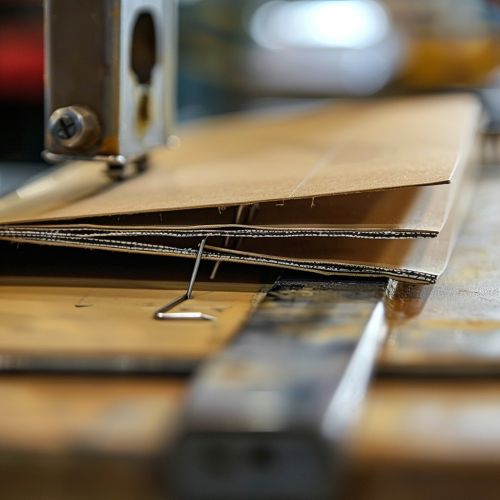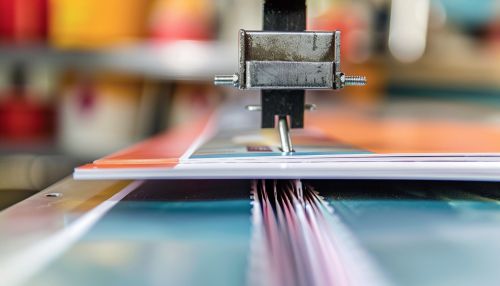Saddle-stitch Binding
Introduction
Saddle-stitch binding is a popular bookbinding method utilized in the production of various types of printed materials, including brochures, booklets, magazines, and catalogs. This technique involves the use of wire staples to secure the pages together through the fold line, creating a durable and professional finish. Saddle-stitch binding is favored for its simplicity, cost-effectiveness, and ability to accommodate a wide range of page counts and sizes.
History and Development
The origins of saddle-stitch binding can be traced back to the early days of bookbinding, where simple stitching techniques were employed to bind pages together. With the advent of the printing press in the 15th century, the demand for more efficient binding methods increased, leading to the development of various stitching techniques, including saddle-stitching. Over time, advancements in technology and materials have refined the process, making it a staple in modern printing and publishing.
Process of Saddle-Stitch Binding
The saddle-stitch binding process involves several key steps:
1. Printing and Folding
The first step in saddle-stitch binding is the printing of the pages. These pages are typically printed in multiples of four, known as signatures, to ensure proper pagination. Once printed, the signatures are folded in half, creating a spine along the fold line.
2. Collating
After folding, the signatures are collated, or gathered, in the correct order. This step is crucial to ensure that the pages are aligned and sequenced properly before stitching.
3. Stitching
The collated signatures are then placed over a saddle-like apparatus, which holds them in place while wire staples are driven through the fold line. The staples are inserted from the outside and clinched on the inside, securing the pages together. This step can be performed manually or using automated stitching machines.
4. Trimming
Once stitched, the edges of the booklet are trimmed to create a clean, uniform finish. This step removes any excess paper and ensures that the pages are flush.


Advantages of Saddle-Stitch Binding
Saddle-stitch binding offers several advantages:
Cost-Effectiveness
One of the primary benefits of saddle-stitch binding is its cost-effectiveness. The materials and equipment required for this binding method are relatively inexpensive, making it an economical choice for both small and large print runs.
Simplicity and Speed
The saddle-stitch binding process is straightforward and can be completed quickly, especially with the use of automated stitching machines. This efficiency makes it ideal for projects with tight deadlines.
Flexibility
Saddle-stitch binding can accommodate a wide range of page counts and sizes, from small booklets to larger magazines. It is also suitable for both short and long print runs, providing versatility for various printing needs.
Lay-Flat Design
One of the notable features of saddle-stitched booklets is their ability to lay flat when opened. This characteristic enhances readability and usability, making it a preferred choice for instructional manuals, catalogs, and other reference materials.
Limitations of Saddle-Stitch Binding
Despite its advantages, saddle-stitch binding has some limitations:
Page Count Restrictions
Saddle-stitch binding is best suited for booklets with a lower page count, typically ranging from 8 to 64 pages. As the number of pages increases, the bulkiness of the spine can cause the booklet to become difficult to handle and may result in pages popping out.
Durability
While saddle-stitched booklets are generally durable, they may not be as robust as other binding methods, such as perfect binding or case binding. The wire staples can potentially rust over time, and the spine may weaken with frequent use.
Applications of Saddle-Stitch Binding
Saddle-stitch binding is used in a variety of applications, including:
Magazines
Many magazines utilize saddle-stitch binding due to its cost-effectiveness and ability to produce a professional finish. The lay-flat design also enhances the reader's experience.
Brochures and Booklets
Saddle-stitch binding is commonly used for brochures and booklets, such as product catalogs, event programs, and informational pamphlets. Its simplicity and quick turnaround make it ideal for marketing materials.
Instruction Manuals
The lay-flat design of saddle-stitched booklets makes them suitable for instructional manuals, user guides, and reference materials. This binding method allows for easy handling and readability.
Newsletters
Organizations and businesses often use saddle-stitch binding for newsletters, as it provides a professional appearance and can be produced cost-effectively in both small and large quantities.
Comparison with Other Binding Methods
Saddle-stitch binding is one of several binding methods available, each with its own advantages and limitations. Some common alternatives include:
Perfect Binding
Perfect binding, also known as adhesive binding, involves the use of a strong adhesive to bind the pages together along the spine. This method is suitable for thicker books and provides a more durable finish. However, it is generally more expensive and time-consuming than saddle-stitch binding.
Case Binding
Case binding, or hardcover binding, is a method that involves sewing the pages together and encasing them in a hard cover. This technique offers the highest level of durability and is often used for high-quality books, such as textbooks and novels. It is also the most expensive and labor-intensive binding method.
Spiral Binding
Spiral binding, also known as coil binding, involves the use of a plastic or metal coil that is threaded through holes punched along the edge of the pages. This method allows the booklet to lay flat and is commonly used for notebooks and calendars. However, it may not provide the same professional appearance as saddle-stitch binding.
Environmental Considerations
Saddle-stitch binding has several environmental considerations:
Material Usage
Saddle-stitch binding typically uses fewer materials compared to other binding methods, such as perfect binding or case binding. This can result in a lower environmental impact, as less paper and adhesive are required.
Recyclability
Saddle-stitched booklets are generally easier to recycle, as they do not contain adhesives or other materials that can complicate the recycling process. The wire staples can be removed, allowing the paper to be recycled more efficiently.
Sustainable Practices
Many printing companies are adopting sustainable practices, such as using recycled paper and environmentally friendly inks. These practices can further reduce the environmental impact of saddle-stitch binding.
Innovations in Saddle-Stitch Binding
Recent advancements in technology have led to several innovations in saddle-stitch binding:
Automated Stitching Machines
Modern automated stitching machines have significantly increased the efficiency and accuracy of the saddle-stitch binding process. These machines can handle large volumes of booklets with minimal human intervention, reducing labor costs and production time.
Digital Printing
The integration of digital printing technology has allowed for greater flexibility and customization in saddle-stitch binding. Digital printing enables short print runs and on-demand printing, making it easier to produce personalized booklets and reduce waste.
Eco-Friendly Materials
The development of eco-friendly materials, such as biodegradable wire staples and recycled paper, has further enhanced the sustainability of saddle-stitch binding. These materials help reduce the environmental impact of the binding process.
Conclusion
Saddle-stitch binding is a versatile and cost-effective binding method that is widely used in the production of various printed materials. Its simplicity, speed, and ability to accommodate a range of page counts and sizes make it a popular choice for magazines, brochures, booklets, and more. While it has some limitations, such as page count restrictions and durability concerns, advancements in technology and materials continue to improve the process and expand its applications.
